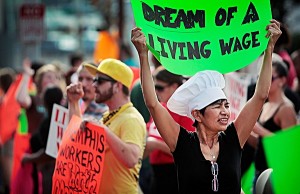 Associate Business Editor Caroline Fairchild in The Huffington Post recently made the argument that not only is a $12 minimum wage affordable, but it would actually help our economy.
Associate Business Editor Caroline Fairchild in The Huffington Post recently made the argument that not only is a $12 minimum wage affordable, but it would actually help our economy.
A report from non-partisan public policy center Demos looked into the effect of large retailers raising wages to pay the equivalent of $25,000 per year, or $12.25 per hour, for full-time, year-round workers. The study revealed that the wage hike could benefit not only workers, but also retailers and the economy at large.
Here are some key takeaways from the report:
1. More than 700,000 American workers would be lifted out of poverty
More than 1 million retail workers and their family members live in or close to poverty. Raising the minimum wage to the equivalent of $12.25 per hour, 734,075 people would be lifted out of poverty and an additional 769,191 people living near the poverty line would see their incomes rise to more than 150 percent above the poverty line. That’s not only good for them, but it eases the tax burden the rest of us have to cover for the benefits they receive. Imagine the burden of subsidizing minimum wage salaries being shifted to the employers, rather than individuals.
2.The GDP would rise by as much as $15.2 billion
3. The creation of 132,000 new jobs
If the increase in economic activity reached $15.2 billion, retailers would need 132,000 new employees.
4. The wage increase would only cost retailers about 1 percent of total sales
Large retailers would need to absorb the higher labor cost for the 3.5 million workers earning less than $12.25 per hour. But according to Demos, most of this increase in costs would be returned to the firm in the form of productivity gains and increased revenues, amounting to only one percent of their total yearly sales.
5. It would generate as much as $5 billion in additional retail revenue
Assuming that low-income families spend rather than save the money from the wage increase, retailers could expect at least 20 cents in new revenue for every additional payroll dollar.
6. The average shopper would pay just 15 cents more per shopping trip at most
Even if the nation’s largest retailers decided to pass off the cost of a $12.25 minimum wage increase entirely to customers, Demos found that an average household would spend just 7 to 15 cents more per shopping trip.

I also posted this on FB> While the economic argument is valid, and on that basis alone increasing the minimum wage should be a no brainer. But what about moral and ethical considerations? What about our obligations under The Universal Declaration of Human Rights, or do we just cherry pick the ones we like and/or what others to observe? For example: Article 23.3 “Everyone who works has the right to just and favourable remuneration ensuring for himself and his family an existence worthy of human dignity, and supplemented, if necessary, by other means of social protection.” And Article 25.1 ” Everyone has the right to a standard of living adequate for the health and well-being of himself and of his family, …”
The goal of $12.25 an hour is fine. However just mandating higher wages is going to create wage inflation which is unsustainable. You can look at countries like Argentina, where wages rise 20% or more a year but then they have to depreciate the currency wiping out most of these gains. Wage increases need to have some basis in improved productivity. I think it would be better to create incentives for a stronger economy. For example if you look at China right now, factory wages are skyrocketing because the economy is booming and factories have to compete for workers. It’s the same for software developers in the USA, especially high-level ones.
Also, we have a huge trade deficit and after many years, are finally starting to make a little traction in manufacturing. It’s really not the right time to introduce a huge minimum wage increase